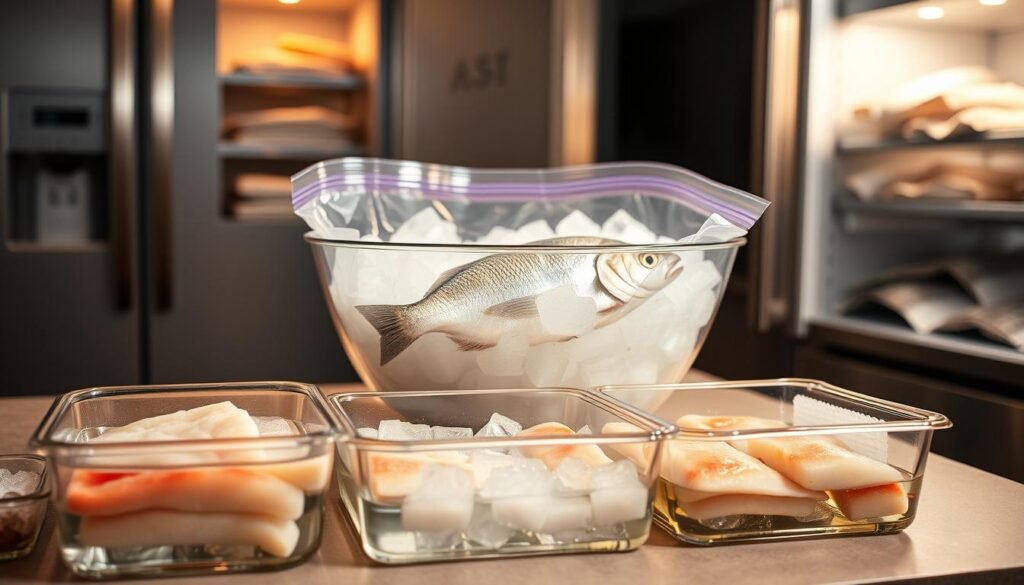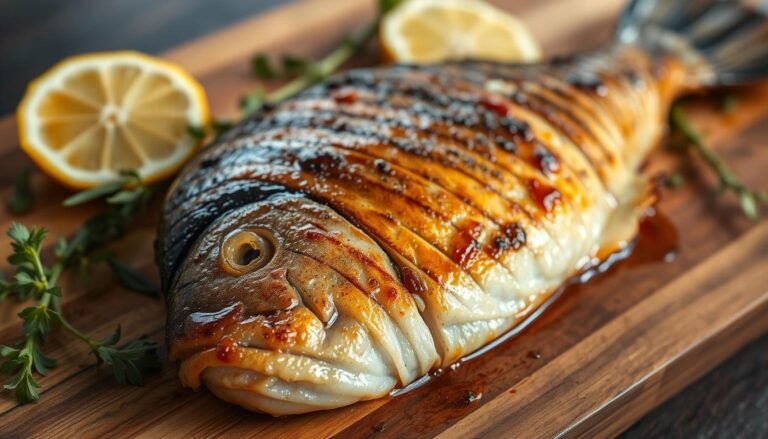Properly storing your catch is crucial to maintaining its freshness and quality. Whether you’re an avid angler or just enjoy fresh seafood, knowing how to store fish at home can make a significant difference. Storing fresh fish requires attention to detail to prevent bacterial growth and spoilage.
To keep your fish fresh for a longer period, it’s essential to follow some simple fish storage tips. According to experts, cooling fish to a temperature between 0°C to 4°C promptly is vital. For more detailed guidance, you can refer to resources like Penn State Extension on proper care and handling of fish.
Key Takeaways
- Cool fish to 0°C to 4°C promptly to prevent bacterial growth.
- Store unfrozen fish in a covered container in the refrigerator.
- Use within two days for optimal freshness.
- Keep raw fish separated from ready-to-eat foods.
- Marinate fish in the refrigerator for enhanced flavour.
Why Proper Fish Storage Matters
Proper fish storage is crucial for maintaining the quality and safety of your catch. When fish is not stored correctly, it can lead to spoilage, making it unsafe for consumption.
The Science Behind Fish Spoilage
Fish spoilage is primarily caused by the growth of bacteria and enzymes that break down the fish’s tissues. Temperature control is key in slowing down this process. According to the source “Proper Care and Handling of Fish from Stream to Table,” proper handling and storage of fish are crucial to prevent foodborne illness.
Health Risks of Poorly Preserved Fish
Consuming poorly preserved fish can lead to foodborne illnesses, including scombroid poisoning and botulism. Proper refrigeration tips for fish can significantly reduce these risks by keeping the fish at a consistently low temperature.
Economic Benefits of Reducing Waste
Proper fish storage not only ensures safety and quality but also has economic benefits. By reducing waste through effective storing fresh fish methods, consumers and businesses can save money and reduce their environmental impact.
| Storage Method | Benefits | Impact |
|---|---|---|
| Refrigeration | Slows down bacterial growth | Reduces spoilage |
| Proper Handling | Prevents damage to fish tissues | Maintains quality |
| Freezing | Halts bacterial growth | Extends storage life |
Identifying Fresh Fish: What to Look For
The freshness of fish is vital for both taste and food safety, making it essential to know what to look for. Whether you’re purchasing fish from a market or handling a fresh catch, identifying its quality is crucial.
Visual Indicators of Quality Fish
When examining fish, the first thing to check is its appearance. Fresh fish typically have bright, clear eyes that are not sunken. The gills should be red or pink, indicating good oxygen supply. The scales should be shiny and firmly attached to the skin.

According to the guide “Proper Care and Handling of Fish from Stream to Table,” checking fish for signs of disease or parasites is crucial. Healthy fish have bright, clear eyes, and red gills.
The Smell and Texture Test
Fresh fish should have a mild smell, similar to the ocean or seaweed. A strong, fishy odor is often a sign of spoilage. The texture of fresh fish is firm and springs back when touched.
“The best way to ensure you’re getting fresh fish is to check its smell and texture. Fresh fish should smell like the sea and have a firm texture.”
When to Discard Fish: Warning Signs
There are several warning signs that indicate fish is no longer safe to eat. These include a strong, unpleasant odor, slimy texture, and visible signs of mold or parasites. If you notice any of these signs, it’s best to discard the fish.
| Indicator | Fresh Fish | Spoiled Fish |
|---|---|---|
| Eyes | Bright, clear | Dull, sunken |
| Gills | Red or pink | Brown or gray |
| Smell | Mild, ocean-like | Strong, fishy |
| Texture | Firm, springs back | Slimy, soft |
Essential Fish Storage Tips for Home Use
To keep your fish fresh for longer, it’s crucial to follow some essential storage tips right from the moment you catch it. Proper handling and storage are key to maintaining the quality and safety of your catch.
Immediate Post-Catch Handling
The way you handle fish immediately after catching is critical. According to “Proper Care and Handling of Fish from Stream to Table,” bleeding, gutting, and cooling the fish as soon as possible are crucial steps. Bleeding helps improve the fish’s appearance and quality by reducing blood clots in the flesh. Gutting removes the innards, which can spoil quickly and affect the rest of the fish.
Cooling the fish rapidly is also vital. This can be achieved by using ice or placing the fish in a cool, shaded area. The goal is to lower the fish’s temperature as quickly as possible to slow down bacterial growth.
Proper Cleaning and Gutting Techniques
Cleaning and gutting are not just about removing the innards; they’re also about doing so in a way that minimizes damage to the fish and prevents contamination. Use clean, sharp tools to make precise cuts, and avoid cutting too deeply into the flesh.
Temperature Control Fundamentals
Temperature control is fundamental in keeping fish fresh. Fish should be stored at a temperature just above freezing. The ideal storage temperature is between 0°C and 4°C. This slows down the growth of bacteria and other pathogens.
Australian Food Safety Standards for Fish
Australia has strict food safety standards for handling and storing fish. The Australian Food Safety Standards require that fish be handled and stored in a way that prevents contamination and keeps it at the correct temperature. Familiarizing yourself with these standards can help ensure your catch remains safe to eat.
By following these essential fish storage tips, you can enjoy your catch for longer while maintaining its quality and safety.
Refrigeration Methods for Short-Term Storage
Effective short-term storage of fish relies heavily on proper refrigeration practices. Maintaining the right temperature and handling techniques are crucial to preserving the freshness and quality of your catch.
Optimal Fridge Settings and Placement
The ideal refrigerator temperature for storing fish is between 0°C and 4°C. It’s essential to place the fish in the coldest part of the fridge, usually the bottom shelf, to maintain a consistent refrigerated temperature. According to guidelines, fish should be stored in a covered container to prevent cross-contamination and absorption of odors from other foods.
Best Wrapping Materials and Containers
For short-term storage, wrapping fish in plastic wrap or aluminum foil and placing it in a covered container can help maintain freshness. Alternatively, using airtight containers or zip-top bags can prevent moisture from escaping and other flavors from being absorbed. It’s crucial to keep raw fish separate from ready-to-eat foods to prevent cross-contamination.

Storage Times for Different Fish Types
The storage time can vary depending on the type of fish. Generally, fish can be safely stored in the refrigerator for up to two days. However, the storage duration can differ for lean and fatty fish.
Lean Fish Storage Guidelines
Lean fish, such as snapper and flathead, typically have a slightly longer storage life due to their lower fat content. They can usually be stored for up to 48 hours in the refrigerator.
Fatty Fish Considerations
Fatty fish like mackerel and tuna are more prone to oxidation and spoilage due to their higher fat content. They should be consumed within 24 hours for optimal freshness and quality.
By following these refrigeration tips for fish, you can enjoy your catch for a longer period while maintaining its freshness and safety.
Freezing Fish: Techniques for Long-Term Preservation
Long-term preservation of fish can be achieved through proper freezing techniques. Freezing is an effective way to maintain the quality and freshness of fish, allowing you to enjoy your catch for months to come.
Preparing Fish for the Freezer
Before freezing, it’s essential to prepare the fish properly. This involves cleaning, gutting, and scaling the fish, followed by rinsing it under cold water to remove any remaining blood or debris. After preparation, pat the fish dry with paper towels to remove excess moisture, which helps prevent the formation of ice crystals during freezing.
Vacuum Sealing vs. Traditional Methods
When it comes to packaging fish for freezing, there are several methods to consider. Traditional methods include using heavily waxed paper, freezer wrap, or plastic freezer storage bags. However, vacuum sealing has gained popularity due to its effectiveness in removing air from the packaging, which significantly reduces the risk of freezer burn. According to the source “Proper Care and Handling of Fish from Stream to Table,” removing air from the bag before sealing is crucial for maintaining the quality of the fish.
Preventing Freezer Burn and Flavour Loss
Freezer burn can be a significant issue when storing fish for extended periods. To prevent this, it’s crucial to store the fish at 0°F (-18°C) or below. Proper packaging, such as vacuum sealing or using airtight containers, also plays a vital role. Additionally, labeling the packages with the date and contents can help you keep track of how long the fish has been stored.
| Fish Type | Freezer Storage Life | Tips for Storage |
|---|---|---|
| Fatty Fish (Salmon, Tuna) | 2-3 months | Use vacuum sealing to prevent oxidation |
| Lean Fish (Cod, Snapper) | 6-8 months | Store in airtight containers to maintain freshness |
| Shellfish | 3-6 months | Freeze in a single layer on a baking sheet before transferring to airtight containers |
Safe Thawing Practices
When it’s time to use your frozen fish, thawing it safely is crucial to prevent bacterial growth. The recommended method is to thaw the fish in the refrigerator or under cold running water. Never thaw fish at room temperature. Once thawed, cook the fish immediately and do not refreeze it.
By following these techniques for freezing and thawing fish, you can enjoy your catch year-round while maintaining its quality and freshness. Proper fish storage tips at home not only ensure that your fish remains safe to eat but also retains its flavor and nutritional value.
Alternative Preservation Methods for Australian Conditions
Beyond refrigeration, there are several effective methods for preserving fish that are particularly suited to Australian conditions. These alternative preservation techniques not only extend the shelf life of your catch but also add unique flavors and textures.
Home Smoking Techniques
Smoking fish is a popular preservation method that infuses a rich, smoky flavor. To smoke fish at home, you’ll need a smoker or a DIY setup with a wire rack and a lid. Maintaining a consistent temperature between 65°C to 90°C is crucial for food safety and quality. According to “Proper Care and Handling of Fish from Stream to Table,” salting before smoking is essential for drawing out moisture and enhancing flavor.
Salt Curing in Humid Climates
Salt curing is an effective preservation method, but it requires careful consideration in Australia’s humid climates. To combat humidity, it’s essential to use a mixture of salt and sugar to draw out moisture and prevent bacterial growth. Regularly monitoring the curing process and ensuring the fish is stored in a cool, dry place are critical steps.
Pickling and Marinating Australian-Style
Pickling and marinating are excellent ways to preserve fish while adding a burst of flavor. Australians can enjoy a variety of pickling liquids, from vinegar-based to those incorporating native ingredients like lemon myrtle. Using fresh, high-quality ingredients and maintaining proper hygiene during the pickling process are key to safe and delicious results.
Drying Fish in Various Australian Climates
Drying fish is another preservation method that can be adapted to different Australian climates. In tropical regions, it’s crucial to protect the fish from insects and high humidity, while in temperate zones, controlling temperature and airflow is vital. Using a food dehydrator or a simple drying rack can help achieve the desired dryness without compromising food safety.
By exploring these alternative preservation methods, Australians can enjoy their fresh catch for longer and experience a range of flavors and textures. Whether you’re in the tropics or a temperate region, there’s a preservation technique suited to your local conditions.
Storage Solutions for Popular Australian Fish Species
From the tropical Barramundi to the oily Mackerel, understanding the storage needs of popular Australian fish is crucial for anglers and home cooks alike. Different fish species have unique characteristics that affect how they should be stored to maintain freshness and quality.
Barramundi and Tropical Fish Storage
Barramundi, a favorite among Australian anglers, requires careful handling to preserve its delicate flavor. For tropical fish like Barramundi, it’s essential to store them in a cool, refrigerated environment as soon as possible after catch. Refrigeration at a consistent temperature below 4°C is crucial. Wrapping the fish in ice or storing it in a sealed container with ice packs can help maintain the required low temperature.
Preserving Snapper, Flathead and Other Reef Fish
Snapper and Flathead are popular reef fish that benefit from proper storage techniques. These fish should be gutted and cleaned promptly, then stored in a refrigerator or on ice. Using a vacuum sealer can help prevent freezer burn if you plan to freeze them. For short-term storage, keeping them in a covered container surrounded by ice is effective.
Handling Delicate Species like Whiting and Bream
Delicate fish like Whiting and Bream require gentle handling to preserve their texture and flavor. It’s recommended to store them on ice or in a refrigerated environment, ensuring they are kept at a consistent low temperature. Avoiding direct contact with ice by wrapping them in plastic or aluminum foil can prevent damage to their skin and flesh.
Storage for Oily Fish: Mackerel, Tuna and Salmon
Oily fish such as Mackerel, Tuna, and Salmon have a higher fat content, making them more prone to oxidation and spoilage. Storing them at very low temperatures, either by freezing or keeping them on ice, is essential. For frozen storage, vacuum sealing can help prevent freezer burn and maintain the fish’s quality.
By understanding the specific storage needs of different Australian fish species, anglers and home cooks can enjoy their catch for longer while maintaining its quality and safety.
Equipment and Tools for Optimal Fish Storage at Home
To keep your catch fresh for a longer period, it’s essential to have the right equipment for fish storage at home. Proper storage not only maintains the quality of the fish but also ensures food safety. According to the guidelines from “Proper Care and Handling of Fish from Stream to, using clean equipment and storing fish at the correct temperature are crucial steps.
Essential Storage Containers for Australian Kitchens
For storing fish in the fridge or freezer, you’ll need containers that are airtight and moisture-proof. Glass or plastic containers with tight-fitting lids are ideal. Some popular options include:
- Glass containers with locking lids
- BPA-free plastic containers
- Reusable silicone bags
Temperature Monitoring Devices
Maintaining the right temperature is critical for fish storage. A thermometer can help ensure your fridge or freezer is at the optimal temperature. Digital thermometers provide quick and accurate readings.
Vacuum Sealers: Models Available in Australia
Vacuum sealing is an effective method for removing air from storage bags, which helps prevent freezer burn and maintains the fish’s freshness. Some popular vacuum sealer models in Australia include:
| Model | Features |
|---|---|
| Model A | Compact design, easy to use |
| Model B | Advanced sealing technology, large capacity |
Coolers and Ice Solutions for Fishing Trips
For those who enjoy fishing, having a cooler with ice is essential for keeping the catch fresh during transport. Look for coolers with good insulation and consider using ice packs or frozen gel packs.
“The key to keeping fish fresh is to cool it down as quickly as possible and keep it at a low temperature.” – Australian Fishing Guide
By investing in the right equipment and following proper storage techniques, you can enjoy your fresh catch for a longer period.
Conclusion: Enjoying Fresh Fish Year-Round
By following the fish storage tips outlined in this article, you can enjoy fresh fish at home whenever you want. Proper refrigeration tips for fish are crucial in maintaining the quality and safety of your catch. Whether you’re storing fish in the fridge or freezer, using the right fish storage tips home can make all the difference.
Implementing these simple techniques will help you preserve the freshness of your fish, reduce waste, and save money. With the right storage methods, you can savor the taste of your favorite fish species throughout the year. From refrigeration to freezing, and alternative preservation methods, you’re now equipped with the knowledge to keep your fish fresh.
By applying these practical tips, you’ll be able to enjoy your catch at its best, whether it’s a freshly caught Barramundi or a store-bought Snapper. So, go ahead and indulge in the delight of fresh fish, knowing you’re storing it safely and efficiently.





